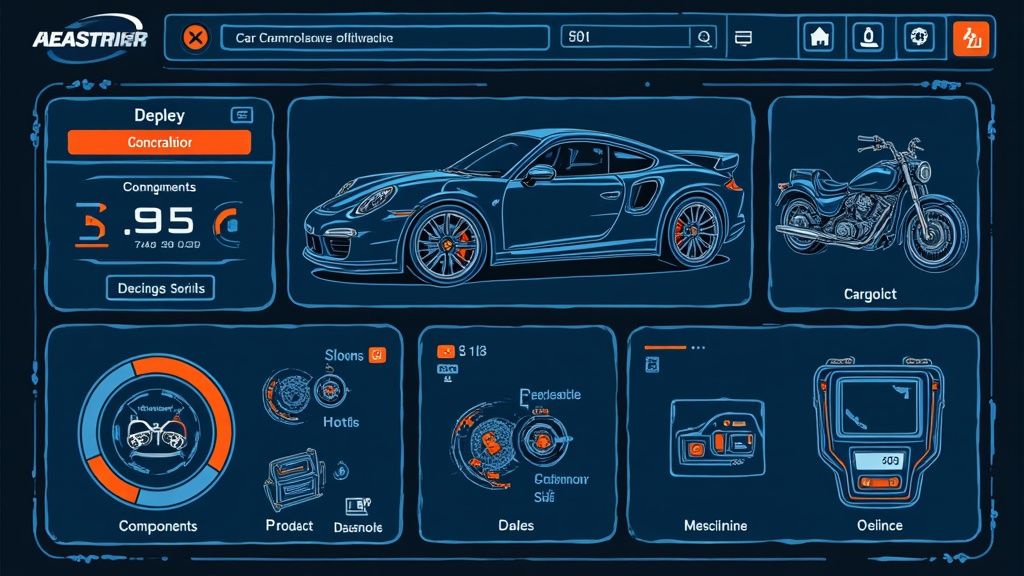
Vehicle Maintenance Software: The Ultimate Guide to Transforming Fleet Management
Understanding the True Impact of Modern Fleet Technology

Fleet management is moving in a new direction, with companies shifting from reactive fixes to data-driven maintenance powered by vehicle maintenance software. This isn’t just about adding new tools - it’s a fundamental change in how fleets handle vehicle care and cost management. Instead of relying on basic spreadsheets and manual tracking, fleet managers now use real-time data to optimize maintenance schedules, spot potential problems early, and boost overall efficiency. While this transition brings clear benefits, it also requires careful planning and implementation.
Why Traditional Maintenance Approaches Fall Short
The old way of maintaining fleet vehicles based on fixed mileage or time intervals has serious drawbacks. Often, vehicles receive unnecessary service while others develop problems between scheduled maintenance checks. This leads to more vehicle downtime, higher repair expenses, and reduced productivity. Manual record-keeping makes it hard to accurately track maintenance history or identify recurring issues. Without real-time monitoring of vehicle health, problems can escalate quickly before they’re discovered. These limitations make it difficult for fleet managers to make smart decisions about vehicle maintenance.
The Power of Real-Time Data and Analytics
Modern fleet maintenance software addresses these challenges by providing instant visibility into how vehicles are performing. Using telematics systems and diagnostic tools, these platforms collect detailed data on mileage, fuel use, engine health, and driving patterns. For example, sensors can detect gradual tire pressure drops early, allowing teams to fix issues before they cause problems on the road. This data helps fleet managers schedule maintenance more effectively and allocate resources where they’re needed most. The software also handles routine tasks like maintenance scheduling and parts tracking automatically, giving managers more time for strategic planning. With artificial intelligence capabilities, these systems can even predict when maintenance will be needed before problems occur.
Embracing the Change: Evaluating Your Current Strategy
To get the most from fleet maintenance software, companies should take a close look at their current approach and find specific areas to improve. Key questions to consider include:
- Does your preventative maintenance schedule work well, or do you face frequent unexpected repairs?
- How many hours do staff spend on paperwork and administrative maintenance tasks?
- Can you easily check the current condition and performance of your vehicles?
- Are you having trouble keeping up with maintenance regulations and requirements?
By carefully assessing your current practices, you can identify exactly where maintenance software will have the biggest impact. This focused approach helps ensure a smooth transition to new technology and maximizes the value of investing in a robust solution like Auto Service Logger. Taking these steps allows companies to fully benefit from the efficiency gains and cost savings that modern fleet technology provides.
Mastering Predictive Maintenance for Real Results

Fleet managers are discovering that real-time data alone isn’t enough - the key is getting ahead of problems before they happen. By adopting predictive maintenance powered by artificial intelligence and machine learning, companies can spot potential issues weeks in advance. It’s like having a skilled mechanic constantly monitoring every vehicle’s vital signs, ready to flag the smallest warning signs before they become major problems.
How Predictive Maintenance Works
The process relies on analyzing data from three key sources working together:
- Sensor Data: On-board telematics systems track real-time metrics like engine performance, tire pressure, and fuel usage
- Driver Feedback: Regular input from drivers about vehicle behavior and unusual sounds provides vital early warnings
- Maintenance History: Past repair records help identify patterns that could signal future issues
When combined, this data allows maintenance software to catch subtle changes that humans might miss. For example, if engine temperature creeps up while fuel efficiency drops slightly, it could mean cooling system problems are developing. Finding these patterns early lets managers fix issues before vehicles break down. You might be interested in: How to master your fleet maintenance.
The Benefits of Predictive Maintenance
The numbers show why predictive maintenance makes such a difference. Studies indicate it can cut vehicle downtime by up to 50% while extending vehicle life by 20-40%. This translates directly to lower repair costs, less time spent in the shop, and better overall fleet efficiency. Beyond the financial benefits, catching problems early also means safer vehicles on the road.
Implementing Predictive Maintenance in Your Fleet
Making the switch to predictive maintenance takes careful planning. Here are the key steps:
- Choose the Right Software: Look for maintenance platforms with strong predictive features that work with your existing systems
- Data Integration: Connect all your data sources smoothly - from telematics to driver reports to maintenance records
- Clear Procedures: Set specific steps for handling predictive alerts, including what to inspect and when to repair
- Team Training: Make sure your maintenance staff understands how to read and act on the predictive data
The Future of Predictive Maintenance
As the technology improves, predictive maintenance keeps getting better at spotting problems earlier and more accurately. We’re also seeing it work more closely with other fleet systems - like fuel tracking and route planning - to boost overall efficiency. This data-driven approach gives fleet managers the insights they need to keep vehicles running smoothly while controlling costs.
Navigating Complex Compliance Without the Headache

Fleet managers face an ongoing challenge keeping up with changing regulations while maintaining efficient operations. Consider the daunting task of manually tracking emissions data across hundreds of vehicles - it’s practically impossible without proper software tools. Vehicle maintenance software provides an essential solution by organizing and automating compliance processes.
Streamlining Compliance Tracking and Reporting
Rather than sorting through stacks of paperwork or multiple spreadsheets, vehicle maintenance software centralizes all maintenance records, inspection data, and repair information in one place. This makes it simple to generate accurate reports when needed and significantly reduces compliance risks. Many solutions also include automated reporting features that save time and ensure nothing falls through the cracks.
Managing Mixed Fleets and Diverse Requirements
Most fleets include various vehicle types, from traditional gas-powered to electric vehicles, each with unique maintenance schedules and regulatory needs. Vehicle maintenance software helps managers track these different requirements effectively within a single system. For instance, managers can set up custom maintenance schedules and compliance checklists tailored to each vehicle type while managing everything from one dashboard.
Staying Ahead of Evolving Regulations
Keeping pace with changing emissions, safety and operational regulations requires constant attention. Modern vehicle maintenance software helps by providing timely updates about new requirements. Some platforms connect directly to regulatory databases for real-time alerts about upcoming changes. This allows fleet managers to proactively adjust their maintenance programs instead of scrambling to catch up. You might be interested in: How to master your fleet maintenance.
Integrating Sustainability Metrics and Reporting
Environmental compliance adds another important dimension to fleet management. Vehicle maintenance software lets managers monitor key metrics like fuel usage, emissions and mileage to demonstrate regulatory compliance and environmental responsibility. By analyzing this data, fleets can identify opportunities to improve efficiency and reduce their carbon footprint. The result is both cost savings and better environmental stewardship - making the software a valuable tool for managing today’s complex regulatory requirements.
Proving ROI Beyond the Numbers

While cost reduction is important, showing the true value of vehicle maintenance software requires looking at its broader impact on fleet operations. Understanding how this technology improves efficiency and supports long-term goals helps build a strong case for both initial investment and continued use. Let’s explore the key areas where maintenance software delivers measurable results.
Quantifying the Tangible Benefits
The most direct way to demonstrate ROI is through clear cost savings. Fleet managers can track specific metrics like reduced repair costs, less vehicle downtime, and lower fuel usage. For example, when maintenance teams catch and fix small issues early through predictive features, they prevent expensive roadside breakdowns. This proactive approach keeps vehicles running and generating revenue instead of sitting idle in repair shops. The software also helps optimize fuel efficiency by monitoring how vehicles are driven and identifying ways to reduce waste. These concrete savings add up quickly and directly impact the bottom line.
Measuring Efficiency Improvements
The software’s benefits extend beyond direct cost savings into operational improvements. By automating routine tasks like maintenance scheduling and parts tracking, staff can focus on more important work instead of paperwork. The centralized system gives quick access to vehicle histories and maintenance records, which streamlines compliance reporting and reduces risks. This improved oversight helps avoid regulatory fines and keeps operations running smoothly. For instance, having complete maintenance records readily available during inspections prevents compliance issues that could result in costly penalties.
Communicating Value to Stakeholders
Getting continued support requires clearly showing stakeholders how the software benefits the business. This means highlighting both the measurable cost savings and operational improvements like better efficiency and compliance. Using clear data visualizations helps leadership understand key metrics at a glance. Real examples, like graphs showing reduced vehicle downtime or fuel costs over time, make the impact obvious. Including feedback from other fleet managers who use similar systems adds credibility. Taking this comprehensive approach helps stakeholders see the full strategic value of investing in maintenance software, beyond just the financial returns.
Implementation Strategies That Actually Work
A strategic plan is essential for making the most of vehicle maintenance software. Like building a house requires a detailed blueprint before construction begins, successful software implementation needs careful planning around key areas like staff training, data migration, system connections, and support systems.
Staff Training: Empowering Your Team for Success
Getting your team fully comfortable with the new software is critical for success. An effective training program should cover basic functions like navigation and data entry, as well as advanced capabilities such as maintenance forecasting. Regular refresher sessions help teams stay current on new features and best practices. For instance, monthly training updates can help staff build confidence while reducing errors during the transition period. Ongoing education ensures your team can take full advantage of the system’s capabilities.
Data Migration: A Smooth Transition to a New System
Moving existing maintenance records into a new platform requires careful planning to maintain data quality and minimize disruptions. Think of it like organizing a messy garage - you need to sort through everything, remove duplicates, and create a logical system. Taking time upfront to clean and validate data creates a solid foundation for accurate reporting. The right data migration tools designed specifically for maintenance software can help streamline this process while preserving data integrity.
System Integration: Connecting the Dots
Linking your maintenance software with other key systems like telematics and fuel tracking creates a more complete view of fleet operations. For example, when telematics data flows directly into maintenance records, you gain real-time insights into vehicle health and can spot emerging issues early. This connected approach puts all your fleet data in one place, making it easier to track costs, plan resources, and make informed decisions. The result is smoother workflows and better visibility across your operation.
Ongoing Support and Optimization: Maximizing Your Investment
Like vehicles need regular tune-ups, software requires consistent attention to run at its best. Working with a vendor that provides reliable technical support and regular updates helps you quickly resolve issues and access new features as they become available. Think of it as having an expert mechanic for your software - someone who keeps everything running smoothly. Regular system reviews help identify ways to improve efficiency as your fleet’s needs change over time. This ongoing focus on optimization ensures you continue getting value from your investment for years to come.
Preparing Your Fleet for Tomorrow’s Technology
Managing a modern fleet requires staying informed about new technologies that can help operations run better and cost less. While keeping up with rapid changes can feel overwhelming, understanding key trends and planning ahead will set your fleet up for long-term success.
Embracing the Autonomous Future
Self-driving vehicles are becoming more advanced each year. Although fully autonomous fleets are still on the horizon, fleet managers should start preparing now. This means learning about how autonomous systems work and what new maintenance needs they’ll bring - like regular software updates and sensor calibration. Starting small with pilot programs can provide valuable hands-on experience. It’s also smart to choose vehicle maintenance software that will work smoothly with autonomous technology when the time comes.
Harnessing the Power of Connectivity
Better connectivity through 5G networks and IoT devices is changing fleet operations for the better. Vehicles can now send real-time data about their performance, which helps catch problems early and keep everything running efficiently. For example, sensors track important metrics like tire pressure and engine temperature, alerting managers before small issues become big ones. Remote diagnostics and wireless updates also make maintenance simpler. The key is having maintenance software that can put all this valuable data to good use.
Integrating Advanced AI Capabilities
AI tools are becoming essential for smart fleet maintenance. By analyzing data patterns, AI can predict when vehicles will need service, helping prevent breakdowns and extend vehicle life. It also helps optimize maintenance schedules and resource planning while spotting potential safety risks early on. Fleet managers who use AI-powered maintenance software gain a major advantage in proactively caring for their vehicles.
Building a Flexible and Future-Proof Fleet
To successfully adopt new technologies, fleet systems need to be adaptable. Choose maintenance software that can grow with your needs and connect easily with new tools through open APIs and flexible design. Just as important is training your maintenance team to effectively use these new systems and understand the data they provide. By investing in both technology and people, fleet managers can build operations ready for whatever comes next.
Ready to improve your fleet maintenance and prepare for future technology? Auto Service Logger offers complete fleet management tools to meet all your maintenance needs. Visit Auto Service Logger today to learn more and request a demo.